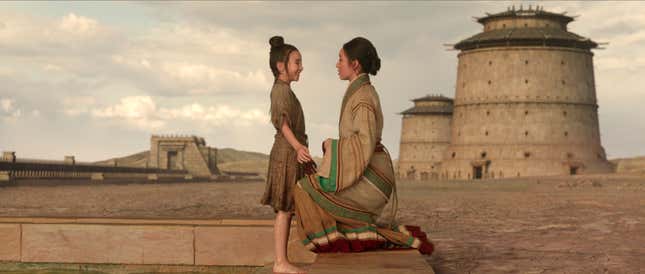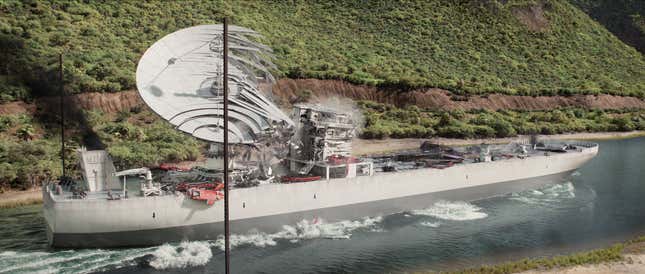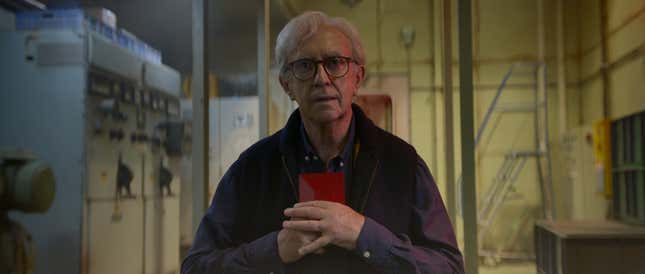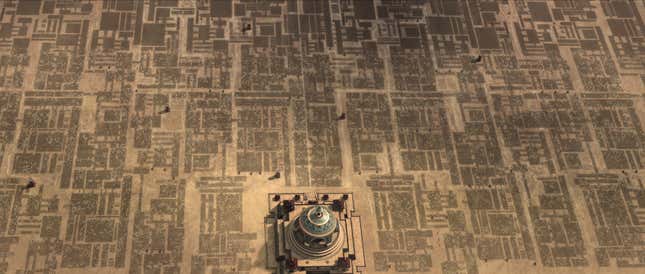Netflix’s 3 Physique Drawback gained over audiences with its sci-fi mysteries, advanced characters, and startling visuals. For those who’re nonetheless haunted by that Panama Canal scene—by which a ship full of individuals is sliced into ribbons—or the unpredictable landscapes of the VR sport world, right here’s a peek behind how they got here collectively.
On this VFX reel supplied completely to io9 by the Netflix-owned Scanline VFX, you will get a take a look at the Panama Canal scene, in addition to two memorable sequences from the VR world: the dehydration/rehydration of the “Follower” who’s consistently doomed by decisions made within the sport, and the scene by which the world loses gravity and everybody begins floating into the sky. Try the video right here!
io9 additionally received an opportunity to talk over e mail with one of many two VFX supervisors at Scanline who labored on this challenge, Boris Schmidt. He, together with Mathew Giampa, reported to 3 Physique Drawback’s general VFX supervisor Stefen Fangmeier, and VFX producer Steve Kullback, a reunion for Scanline since additionally they labored with the identical duo on Sport of Thrones.
Cheryl Eddy, io9: On a challenge like 3 Physique Drawback, how a lot of what you create is pulled straight from the script, and the way a lot is left open to inventive interpretations?
Boris Schmidt: In a challenge like 3 Physique Drawback, a good portion of what we create is guided by the script, making certain the core narrative parts stay. Nevertheless, there may be substantial room for inventive interpretation, notably in areas the place visible storytelling and particular results are advanced and strange.
For example, the event of the search for the assorted huge landscapes, particularly within the thousands and thousands years time-lapse sequence, relied closely on artwork course and artistic imaginative and prescient. These scenes allowed for creativity in visible results, with the pliability to seize the otherworldly qualities of the landscapes and VFX.
Equally, the consequences surrounding the rehydration course of and the depiction of a crumbling, deep-frozen lady (the “Follower” character) had been topic to inventive interpretation. These visible parts wanted to evoke emotion and awe, whereas nonetheless adhering to the broader narrative and editorial context. The artwork course in these circumstances required a stability of technical talent and artistic creativeness, permitting the consequences to enrich and improve the storyline with out overwhelming it.

io9: What was your place to begin when designing the world inside the VR sport?
Schmidt: Once we had been designing the world inside the VR sport, my place to begin was a complete understanding of the shopper’s imaginative and prescient and the challenge’s core idea. The method concerned a number of key steps:
1. Collaboration with the shopper:
I started by speaking with the shopper VFX-supervisor Stefen Fangmeier to grasp his expectations, storyline, gameplay mechanics, and aesthetic imaginative and prescient. These discussions set the inspiration for the complete design course of.
2. Gathering idea artwork and references:
I collected and reviewed any idea artwork, storyboards, or previs edits supplied by the shopper. This helped me perceive the specified visible type, atmosphere structure, and general tone of the sport world. I additionally gathered reference pictures from the web, specializing in parts like structure, landscapes, textures, and coloration palettes to broaden the artistic scope. In some circumstances we used Generative AI to assemble extra reference.
3. Analyzing supplied Unreal Sport-Engine previs recordsdata:
We analyzed present game-engine recordsdata that had been used to create the previs, to realize insights into scene structure and discover numerous digicam angles.
4. Brainstorming and planning:
After gathering all the required references and data, I engaged in brainstorming classes with the assorted division supervisors and leads. This part concerned sketching preliminary ideas, outlining the sport world structure, and contemplating easy methods to creatively and technically construct these worlds.
5. Constructing the digital atmosphere:
As soon as we had a transparent plan, we started constructing the digital environments. This concerned creating environments, 3D fashions, texturing, lighting, advanced FX setups, crowds, and so forth. From this level on we constantly refined the design via iterative overview conferences and shopper suggestions.
io9: The VR sport world is usually huge landscapes and crowds, however there are additionally some up-close, intimate moments, together with the “dehydrating” and “rehydrating” sequence seen within the reel. How did you strategy creating that individual collection of results?
Schmidt: The impact required important analysis and growth, however after contemplating numerous strategies, we selected the next strategy:
First, we constructed an inside skeleton geo for the principle character so it may act as a collider for the outer pores and skin mesh. This skeleton and the outer pores and skin had been each managed by the identical animation rig, so we may pose and animate them utilizing common animation instruments. We used Houdini’s Vellum material simulation to flatten the pores and skin and bones, then rolled them up with one other rig and material simulation. We additionally rolled up the character rig itself to permit for a coordinated unrolling impact. We managed the timing of those simulations with 3D gradients and noises to get a extra exact inventive course.

The bones and pores and skin had been inflated by a set of 3D gradients, permitting us to regulate the timing for each individually. These gradients additionally helped us transition between three totally different floor shaders: one which made the pores and skin look dry and leathery, one other that gave it a translucent impact, and a ultimate shader for the human pores and skin. The shader transitions had been based mostly on the floor curvature and simulation attributes. We used a stress map that confirmed the place the character’s pores and skin was stretched or compressed to create extra results. We additionally used a curvature map to find out concave and convex areas, which helped add wonderful particulars and further texture to the floor.
The hair was simulated individually, with information splines created in Houdini after which transferred to Maya. We determined to render all shader variations and transitions separate to offer full management in compositing. This got here at the price of heavy render-times, together with the gorgeous translucent look, the place you may nonetheless see the interior skeleton.
Then, we fine-tuned the outcomes by making changes and eradicating any undesirable artifacts utilizing shot-modeling on prime of the ultimate Alembic caches. FX supplied extra aeration simulations and air bubbles that had been emitted from the character. Like at all times, the ultimate look was dialed by including compositing love.
io9: The VR world additionally, without delay level, experiences a complete lack of gravity. What references did you’ve got for the motion in that scene, which is a mix of terrifying and sleek?
Schmidt: We checked out zero gravity references from the worldwide space-station and pictures of reduced-gravity plane (nickname vomit comet). Plus extra underwater reference we collected for the rehydration scene which additionally had parts of floating zero gravity. We intently analyzed how lengthy hairs are shifting in house and underwater for the little lady character named “the Follower.” We determined to go along with the underwater look, as a result of the house reference felt too stiff and boring in comparison with the flowing underwater movement.
For characters within the foreground we determined to make use of absolutely animated characters, together with the horses, to be able to have extra management and to remain versatile to handle notes. Our animation staff got here up with nice concepts for the horse actions in zero gravity, e.g. kicking with the hooves and rotating the pinnacle, to indicate the panic of the animal on this unusual state of affairs.
For midground and much distant characters we used a mixture of animated, movement captured and ragdoll-simulated characters. Our movement seize staff did an awesome job with suspending the performers on wires to assist with the antigravity really feel. Our FX staff simulated all the non-living belongings just like the disintegrating towers, floating roof tiles, floating banners and flags, and so forth. Our FX staff had the massive problem to drive the general movement of those thousands and thousands of characters and belongings with particle and physics simulations.

io9: The Judgment Day sequence might be probably the most memorable second in the complete collection—it’s so stunning and makes an enormous visible influence. What did you must think about, to make it really feel as real looking as potential?
Schmidt: At this level I wish to give particular recognition to co-VFX supervisor Mathew Giampa for his excellent contribution on the tanker sequence. Mathew’s experience and his artistic imaginative and prescient had been essential to realize such spectacular outcomes. The realism of the sequence was achieved via a mix of parts. Listed below are a number of key parts that had been important.
First, we would have liked to assemble a whole digital illustration of the Panama Canal, specializing in making it seem as lifelike as potential. Our reference was the Culebra Minimize part of the canal, identified for its distinct terrace options. This concerned creating quite a lot of timber and crops native to this area, successfully constructing a whole computer-generated photograph actual atmosphere from the bottom up.
We additionally took on the duty of constructing and serving to to design the tanker named Judgment Day. This required us to match the structure of the deck to the sensible set, making certain that each element was precisely matching. This included numerous belongings, just like the basketball courtroom, helicopter, and touchdown pad, which needed to be positioned exactly on the deck.
One of many difficult points was illustrating the nano filaments, which function on an atomic scale. The cuts they produce are usually not seen till the items start to slip. Depicting this impact on each the tanker and the individuals introduced a visible problem, as there have been no real-world examples to attract from. Our FX staff needed to convincingly painting the size of those slices and the load of the person parts and the way they bodily would work together.
Our look growth and lighting groups performed an important position in tying the whole lot collectively. They labored to make sure that the lighting and shaders had been constant throughout the atmosphere, tanker, and heavy FX simulations.

io9: What was the most important problem you confronted engaged on that escalation of the whole lot throughout the ship being sliced to items?
Schmidt: Designing advanced FX setups for a ship-slicing scene entails orchestrating a symphony of results that should work in unison. This encompasses a number of physics simulations, together with the dramatic cut up of the ship itself, the swirling motion of canal water, and the eruption of soil on the shore as ship and particles crashe onto land.
Alongside these bigger parts are wonderful mud particles kicked up by the influence, and objects tumbling and colliding on the ship’s deck. There are additionally the simulated slicing of human figures, small fragments scattering via the air, and waves of water spray hitting the environment. Fires escape, smoke billows, sparks fly, and occasional explosions erupt because the ship is torn aside.
Coordinating this advanced array of results requires meticulous consideration to element to make sure the continuity of FX all through a number of pictures and throughout numerous departments. Every element should be rigorously art-directed in order that the sequence maintains a seamless stream from begin to end, with all of the totally different parts completely aligned and synchronized. Kudos to our FX staff and all the opposite departments creating this superior sequence.

io9: Which sequence took the longest or probably the most work to finish, and why?
Schmidt: Definitely, the Judgment Day sequence required appreciable time to provide because of the causes detailed within the earlier reply. Different scenes additionally demanded prolonged growth intervals. For example, the reverse gravity scene that includes a floating military took fairly some time as a result of it concerned many distinctive shot sorts, equivalent to simulating zero-gravity water. Moreover, there was the problem of making the human calculator. The ugly scene the place Turing and Newton are sliced by Khan required exact consideration to element. Likewise, the total CGI time-lapse sequence, full with animated gentle setups and clouds, added to the prolonged growth course of.
You may watch 3 Physique Drawback on Netflix.
Need extra io9 information? Try when to anticipate the newest Marvel, Star Wars, and Star Trek releases, what’s subsequent for the DC Universe on movie and TV, and the whole lot you want to find out about the way forward for Physician Who.












Leave a Comment